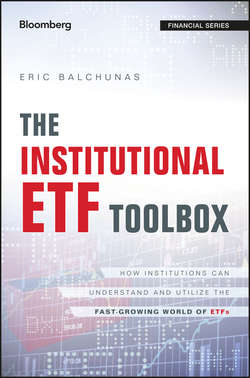Читать книгу The Institutional ETF Toolbox - Balchunas Eric - Страница 13
На сайте Литреса книга снята с продажи.
SECTION I
The ETF Phenomenon
CHAPTER 1
Why Are ETFs So Popular?
Diversification
ОглавлениеWhether it is small caps, China, or biotech, there are just areas where even a large institutional investor simply won’t have an opinion or research on single security names. They may not have the resources to study the area or have chosen not to make a single security bet. ETFs offer an alternative to this by offering exposure to an entire market or country or sector.
“I’m a stock picker, but I use ETFs for things I don’t know about.”
Larry Seibert, 780 Riverside Drive, LLC
Let’s say you are interested in getting exposure to health care. There are hundreds and hundreds of stocks to choose from. Which one do you pick? Many people will opt to use an ETF, which puts your eggs in many baskets. In this way, ETFs let you be more of an economist and less of a stock analyst.
Another important aspect of diversification is dampening volatility. Investing in a group of securities protects you from single-company blow-ups.
Let’s look at an example using the Guggenheim Solar Energy Index ETF (TAN). In October 2014, a sapphire glass company named GT Advanced Technologies Inc. (GTAT) declared bankruptcy after Apple decided not to use their glass in the screen of the iPhone 6.2 The stock quickly dropped 90 percent – a nightmare scenario for GTAT’s stock holders. Imagine if you were bullish solar energy but had only bought GTAT.
Meanwhile, TAN barely noticed it. GTAT was a 3.2 percent weighting, so its contribution to total return (CTR) for TAN on the year was 0.72 percent, as seen in Figure 1.2. Not desirable, but pretty minor considering the stock blew up. ETFs help investors play their themes without the stock selection process undoing the thematic or allocation work up front.
GTAT was also immediately thrown out of the index because it broke the index rules by declaring bankruptcy. This example also exhibits an ETF’s regeneration process – a benefit that doesn’t get brought up too often. Because ETFs track indexes and because those indexes have rules, if a company slips up and breaks the rules, it is going to be kicked out of the index and replaced with a new one.
Not every company burns out; some fade away and before long they are replaced. This Darwinistic process helps your ETF stay in playing shape and evolve with the times. And you don’t have to lift a finger – it’s all done as part of the normal periodic reconstitutions and rebalances and of the index. Figure 1.2 shows the weekly holdings of TAN during October 2014. In the case of GTAT, it was quickly booted out of the index within days of its bankruptcy.
Figure 1.2 TAN’s Holdings Each Week during October 2014
Source: Bloomberg
“ETFs reduce the risk of a WorldCom or an Enron. You have so many risks using just one stock. How do you know there is not fraud risk or an accounting error or a bad product? There’s no way we can do that level of due diligence to figure out if that’s occurring. The ETF is rebalancing. It’s taking out the losers and putting in the winners. We don’t have to do that.”
Sharon Snow, Metropolitan Capital Strategies
Bankruptcies and frauds aside, diversification also dampens day-to-day volatility as well. For example, TAN holds 32 companies involved in the solar energy business. Most are newer, younger, and smaller companies. The average standard deviation for each of the 32 stocks is 63 percent. Meanwhile, the ETF’s standard deviation is about half that, at 38 percent. That is still about triple the standard deviation of the S&P 500 index, but it is just much less volatile than the stocks it holds. This is because the stocks neutralize each other somewhat inside the fund. This is a story you will see across many ETFs.
It must be noted that there is a flip side to diversification, and that is single stock investing can pay off big when a stock surges. Single stock selection lets you feel every basis point of a positive return. Using an example from TAN’s holdings, if you were lucky enough to pick SolarCity Corporation (SCTY), you would have been up 246 percent in the past two years, compared to the diversified TAN, which was up (only) 87 percent.
For those who put in the research and time and think they can pick the right stock (at the right time) and outsmart the army of analysts out there, the ETF probably doesn’t make any sense. But in cases where you don’t put in the time and research or don’t want to take on single-security risk, the diversification of ETFs is a huge benefit. This is also why ETFs are not just drawing away assets from other investment vehicles like mutual funds, but also from single security investors.
2
O’Donnell, Carl, “Apple Supplier GT Advanced Technologies’ Stock Dives 90 % after Bankruptcy Filing.” Forbes, October 6, 2014; www.forbes.com/sites/carlodonnell/2014/10/06/apple-supplier-gt-advanced-technologies-stock-dives-90-after-bankruptcy-filing/.
